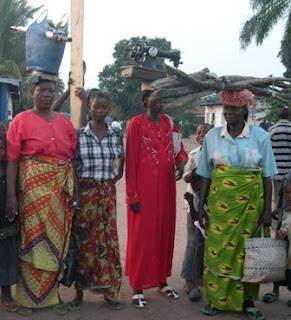 .
.



Older people in the congo can remember when clothes were made out of raffia and bark. Today the Congo is the African center of fashion. Beautiful colorful textiles are produced from 100% cotton fabric wax dyed in brilliant, colors and patterns unique to the Congo. Women wear long dresses with detail work and then cover the skirt of their dress with a pagne, a piece of cloth wrapped around and tucked in the band to anchor it around the waste. The Pagne is a versital piece which is part of the the dress but can be removed and used as a shawl or worn over the head as a cover from the sun or rain. It can be wrapped around an infant and tied on the mothers back to carry the child and leave her hands free. We have been told that the pagne is suppose to only be worn by married women and is noted as an honor and sign prestige.

Dress designs are unique and dresses are decorated with machine embroidery, bias tape, lace and often the fabric itself is used in a way to create a unique design to the dress. Some parts of the dress may be cut on the diagonal or strip pieced with two coordinating fabrics. Much attention can be paid to detail making the dresses artful creations.
Men's shirts are made of the same fabrics as the womens and the design of the shirt is often adding borders or turning one piece of the shirt one way and the other side a different angle.


Fabric can be bought at the market where you will find women selling fabric in small stalls. The stalls often have similar fabrics as the women usually buy their fabrics from the same wholesaler. Fabric is sold in 6 yrd lengths for about $10. The dresses are fashioned so as to leave the salvage edge as the bottom of the dress and the salvage edge shows along with the fabric design label. Often the salvage edge is decorated with medallions or emblems (mark of the dyer) that add to the uniquness of the fabric. Fabric is labeled with glued on paper labels which have to be removed carefully or they become a permanent part of the fabric. It isn’t unusual to see these labels left in place after a dress is made.
 Note the sewing machine being carried on top of the head.
Note the sewing machine being carried on top of the head.Dressmakers and tailors are educated in technical universities and colleges. The skill is very detailed. Most sewing machines are the treddle Singer sewing machines because of the inconsistancy of electricity. It is not unusual to see seamstresses and tailors sewing outside under the mango tree and often they are teaching someone else how to sew.
The following women are all from small villages and what they are wearing is their everyday clothing.



Dressed alike for a funeral Momma and her baby I bought this same fabric -fishes


Sunday dress for church Dressed up for announcement of water project


Dressed up for Sunday








3 comments:
Beautiful dresses, beautiful people.
I love how you are including details we might not otherwise learn about. The dresses are gorgeous and Daddy looks handsome in his sirt. BTW, what was he saying to you when you took his picture?
You really need to have some dresses made for you out of that great fabric. They look very comfortable, although gardening in a dress does not sound enjoyable at all.
Post a Comment